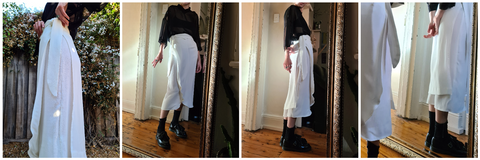Textile waste poses an immediate and substantiated risk to the fashion industry, with eighty-five percent of all textiles ending up in landfill every year. One garbage truck full of textile waste is either burned or put into landfill every second. This constitutes a significant risk to both the well-being of the industry and continued functionality of the earth’s systems. This blogpost will explore the notions of sustainable design and apply zero waste pattern cutting concepts to produce a sustainably made wrap style midi skirt. To further the practice of sewing and explore the ability of zero waste pattern making techniques to be implemented into the production values of the brand.

THE PROBLEM? FAST FASHION
Fashion consumers are purchasing more than ever before. Fueled by fast fashion and consumer demand, clothing production has doubled in the past fifteen years. Global production of fashion garments is now in excess of one hundred billion units per year. If the industry continues its current growth trajectories, the share of humanity’s carbon budget could rise to twenty-six percent by the year 2050. Overfilling landfills and overproduction constitute a few of the ethical and sustainability issues facing the industry, but they require immediate attention if change is to occur.
Current sustainability opportunities in terms of waste management are exacerbated by the problem inherent to the fashion industry’s operating model: fast fashion. Continually increasing the pace of fashion design and production is accelerating the effects of the climate crisis. Humanity is transgressing planetary boundaries at alarming rates and it is posited that existence on earth has now entered a new epoch, the Anthropocene. It is now more apparent than ever, that the planet has been irrevocably altered by human activity . And yet, the fashion industry is not slowing down. More fashion brands are attempting to become a shade of green, but how can they attack the climate crisis efficiently, effectively and creatively? Zero-waste pattern making can rejuvenate the concept of design, eliminate fabric wastage at the production stage and place the value back into fashion.
ZERO WASTE PATTERN CUTTING: A CREATIVE DESIGN PHILOSOPHY
The role of design and product conceptualisation in sustainability is often overlooked. But it is at this stage in the garment manufacturing process, where the carbon footprint of clothing production could be dramatically reduced. Zero waste pattern cutting (ZWPC), a design concept and philosophy, has the potential to reduce textile waste during the manufacturing stage. It does so by creating a pattern that fits entirely within the dimensions of the fabric width and length. Traditional pattern cutting techniques generate on average between fifteen to twenty percent loss of fabric. By utilising innovative design philosophies, ZWPC eliminates this fabric waste and reinvigorates the value in design. It prevents textiles being wasted and the dyes, chemicals, labour, money and time used to produce them. A statistic determined in 2012 highlights the impact of ineffective pattern cutting. In just one year four-hundred billion square meters of fabric was used in the production of fashion garments. Fifteen percent of this is being wasted, simply at the pattern cutting stage of a garment.
Zero waste pattern cutting is not new. It has been necessitating traditional forms of dress globally for thousands of years, like the saree, lungi, dhuti and kimono. The kimono is a historical zero-waste garment originating in Japan in the Heian Period (794-1185), where all components are restricted to the fabric’s length and width. Even in pre-industrial times, fabric was valued as a precious resource, with dressmakers and tailors attempting to utilize the entirety of the textile ordered. Recently, fabric was lost its value. Extenuated by the process of fast fashion, textiles are no longer considered a precious and expensive resource, but an expendable commodity. Fast to market manufacturing and cutting costs at the design stage have been prioritised over the conservation of textiles. Rissanen (2005) states that “pattern making is integral to the design process, rather than a stage that follows it”. And indeed, pattern cutting has become an afterthought, rather than being at the heart of the design process.

By preferencing zero waste pattern cutting in the conceptualisation stage over fast to market production philosophies, the fashion industry has the potential to reduce fabric wastage and integrate textiles more efficiently. Contemporary designers are implementing ZWPC methodologies and articulating them into practice. Holly McQuillan, a zero-waste fashion designer, author and researcher has utilised zero-waste fashion to create sustainable alternatives to traditional fashion garments and uses her research to educate others. Mark Liu, another zero-waste fashion designer, also wanted to “systemically change the way clothing was made” through his practice. These zero-waste advocates and others like them have initiated a sustainable design movement.
Mark Liu and Holly McQuillan, Left to Right.
PRACTICAL ZERO WASTE DESIGN IMPLEMENTATION
The role of a pattern maker is to continually innovate and conceptualize more effective and efficient patterns for fashion garments. Taking elements of zero waste pattern cutting in the historical and contemporary contexts, the following midi skirt and it’s zero waste pattern was created. The pattern is available for download and can be altered easily to suit most fabric widths.


The following skirt hopes to add value to current zero waste pattern cutting research and provide more recognition for the design process and technique. With further implementation and research, zero waste pattern cutting methodologies would be further distinguished as an integral part of the design process, rather than one that follows it. The brand hopes to implement this newly acquired sustainable design technique into future products available.



~ Copyright October 2020


